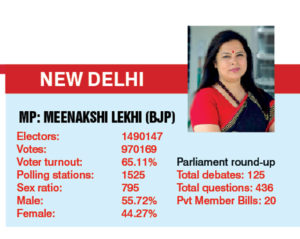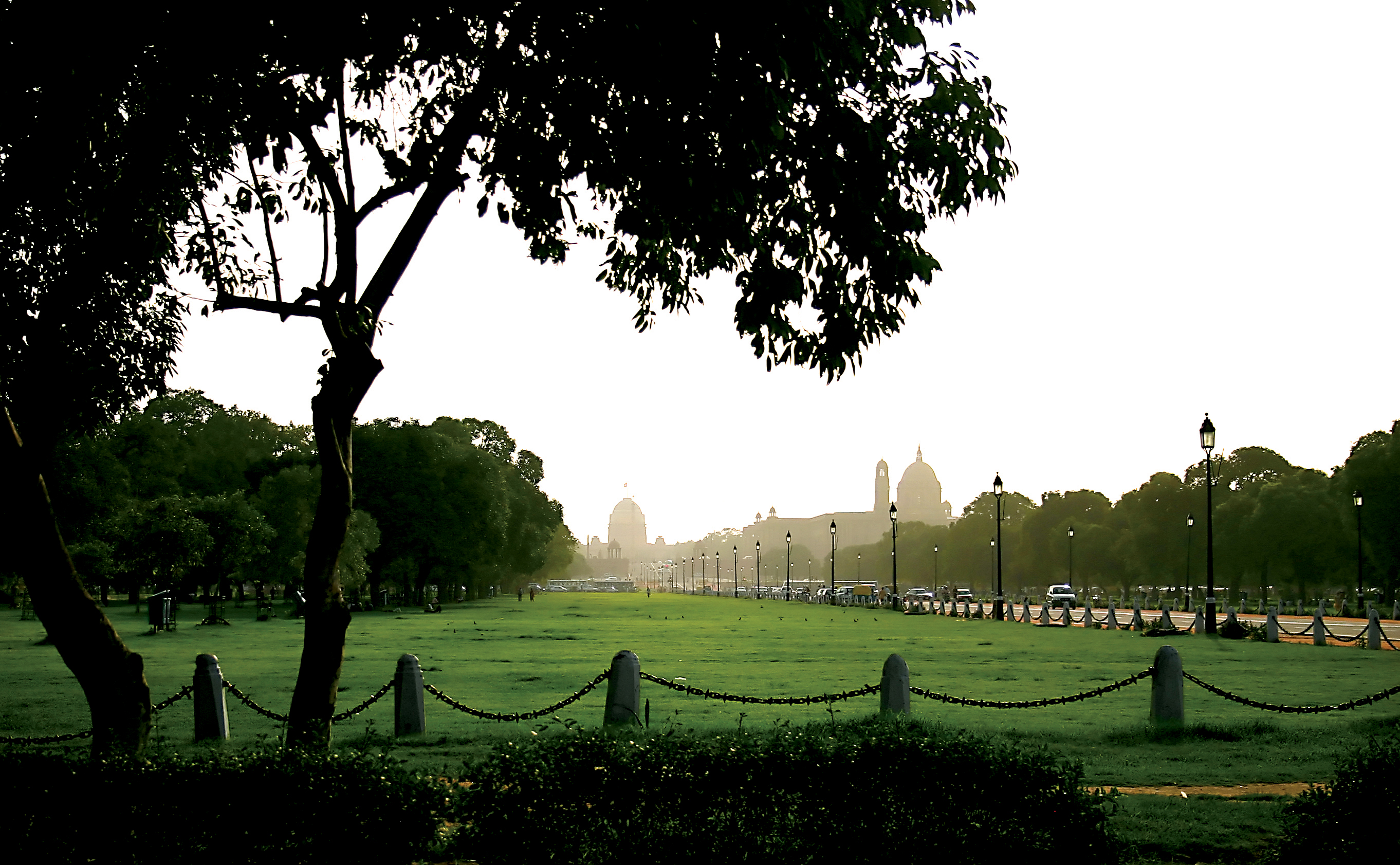Different areas with divergent issues and an unusual voting pattern makes the New Delhi constituency intriguing
Posing a striking contrast to the posh enclave of Lutyens Zone, which first comes to mind when one thinks of the New Delhi constituency, Sujan Singh Park is an area with few redeeming features. The shabby quarters where around 200 families reside are testimony to the lack of development in this area. At one end of the spectrum are the spacious bungalows surrounded by verdant greenery and on the other is an area devoid of proper streets and footpaths.
“The builders don’t have a proof of lease,” says a man in his 80s, on conditions of anonymity. Citing this as the reason for the tawdry condition of the area, Vinod Kumar Sharma, a 59-year-old shopkeeper, questions, “How can you deem a colony that has been in existence for this long unauthorised?”
While the posh Lutyens Zone has seen many “unauthorised occupants” in government bungalows, the people in this area are majorly dealing with two problems — illegality and sealing drive.

Naturally, the voting behaviour of people living in New Delhi constituency is quite different when it comes to the Lok Sabha polls. Since the 1999 general elections, the MP winning the New Delhi constituency has always been from the party in power at the Centre. For instance, Jagmohan secured a win from New Delhi and the Vajpayee government came to power.
In 2004, Ajay Maken won the seat, and the Congress returned to power at the Centre. When the BJP took the reigns as the single largest party in 2014, BJP MP Meenakshi Lekhi, defeated Maken.
This is a constituency where leaders like former PM Atal Bihari Vajpayee, former deputy prime minister LK Advani and BJP leader Jagmohan have won three consecutive elections. However, these elections were conducted over a span of four years because of political turmoil.
Sealing of small and medium commercial units, unauthorised colonies, water and sanitation are a few of the many problems that the constituency has been mired in, causing distress to the residents and creating a demanding task for the current MP.
Sharma says, “Thankfully, water and sanitation issues are not present in our area.” Talking about the 2011 sealing drive, he adds, “When the sealing drive took place, all the shops remained sealed for four years. I had to work in a departmental store in Khanna Market during those years. I used to earn Rs 5,000 a month, which is really meagre.” Prior to the sealing drive, Sharma used to earn around Rs 250-300 per day.
The sealing drive came as a shock to many resident traders. Some also complained that the authorities did not serve notice.
Due to a plea in the Supreme Court, the court had to intervene between the authorities and the public and settled the case with an order that allowed people to run their shops without any hassle.
On January 13, 2014, Sharma finally lifted the shutters of his confectionery shop in Sujan Singh Park. Built in the early 1940s, this neighbourhood was given on lease to a private company called Sir Sobha Singh & Sons. The colony has a pagdi system (controlled by the owner), hence, the monthly rent is Rs 47 for the quarters and about Rs 300 for the flats.
Sharma, who lives with his family of four, has been supporting the BJP since decades now. But he voted for AAP on his sister’s insistence.
“BJP government got us the compensation for our land in Pakistan. I got Rs 1.30 lakh as compensation. This further strengthened my support for BJP.”
He scoffs, “Kejriwal is demanding for statehood to solve the tussle between him and the central government. But one thing has to be noted: It doesn’t work like that.”
As part of the campaign for the 2019 Lok Sabha elections, the AAP government is vehemently raising the issue of full statehood for Delhi. However, Sharma thinks that if Delhi is provided statehood, jurisdictions may clash and the machinery which will come under Delhi government, which “may not be able to handle that.”
“We have so many embassies here, so many international dignitaries come and visit the Capital. I don’t think it’s a viable idea,” adds Sharma.
He also says that Delhi CM Arvind Kejriwal, in bashing the BJP, took the matter to a personal level. “He’s (PM), a senior person to you (Delhi CM), you should not be insulting the PM and his position,” he adds.
Further talking about this dual inclination, he says, “See, AAP government has done good work in areas of education and health, but when it comes to voting in the Lok Sabha elections, I may or may not consider voting for the party.”
The New Delhi constituency also has areas such as Kasturba Nagar, New Delhi, RK Puram, Delhi Cantt and Greater Kailash. Nikita Mahesh, a marketing professional who is a resident of Munirka, speaks about pollution, as RK Puram is one of the areas in the Capital where the AQI was recorded at 948 in 2018.
“The solution to the issue of pollution cannot be expected from the government alone; people themselves don’t work for correcting the situation. No point blaming the MPs and MLAs,” she says.
However, it’s not pollution which makes her hesitant about supporting the current government in Delhi, but the issue of leadership. “AAP shouldn’t come back to power because they lack leadership. They get involved in petty politics. They want fame at the national level and neglect Delhi,” says Mahesh.
She also doesn’t support the demand for full statehood made by the AAP government. “Delhi is the national Capital. It works differently as compared to other cities. Demanding statehood should not be made an election tool to win votes, when other pressing issues like safety, pollution and water supply need urgent redressal,” she concludes.
Other voters Patriot spoke to did not understand the concept of statehood for Delhi.
Perhaps the most colourful battles occurred during the 1991 election, when there was an extremely close battle fought between Bollywood actor Rajesh Khanna (Congress) and LK Advani (BJP). The voter turnout at that time was 2,15,834, out of which 92,073 votes went to Khanna, who was defeated by the 93,662 votes for Advani.
In the 1992 by-election, Khanna won by 28,256 votes, as against his opponent, actor Shatrughan Sinha of BJP, who got 73,369 votes.
From 2004 to 2009, the constituency was in the hands of Congress’ Ajay Maken, with votes crossing 50%. After ruling the roost for 10 years, Maken not only lost to BJP’s Lekhi, getting only 1,82,893 out of 9,69,812 votes, but also trailed behind Ashish Khetan of AAP. This is the constituency that houses the Assembly segment where CM Kejriwal defeated ex-Delhi CM Sheila Dikshit, putting a stop on her 15-year run as the chief minister of the Capital.
Another interesting fact that comes out is the voter turnout. For many decades, the constituency never saw a voter turnout exceeding 2,57,513. However, this augmented during the 2009 general election, where the turnout rose to 7,65,018. It further increased during the 2014 general election, when 9,69,812 people cast their vote.





